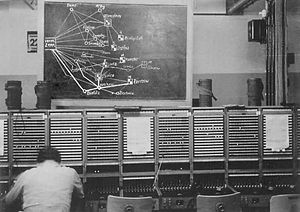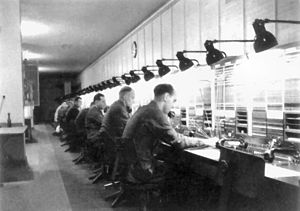Intelligence force from the Wehrmacht and Waffen SS

The intelligence force was a branch of the army of the Wehrmacht and Waffen-SS , which was set up for the establishment and operation of communications links as telephone and radio links. Listening companies, in which soldiers who know foreign languages were on duty, were used especially for eavesdropping on enemy communications .
According to a decree of the Wehrmacht High Command of October 14, 1942, it belonged to the fighting troops of the German Wehrmacht and the Waffen SS until 1945.
The weapon color (Wehrmacht) and weapon color (Waffen-SS) assigned to the intelligence force in 1935 was lemon yellow . The color of the weapons used by the Luftwaffe's air intelligence service, however, was brown .
Prehistory: First World War and Reichswehr
The forerunner of the German intelligence force was the telegraph force formed in 1899 . Telegraph battalions fortress and army telephony departments were in the First World War together in 1917 to signal corps. In addition to radio and telephone connections and the newly developed teleprinters , carrier pigeons and heliographs were also used to transmit messages . During the First World War, radio telegraphy in particular became increasingly important. In 1915, the first use of tactile radios by the air force for artillery observation. In 1916, for the first time, radio teams equipped with mobile radio devices operated in the forefront.
From 1921 onwards, each division in the Reichswehr was subordinated to an intelligence department with two companies . In addition to radio and telephone connections, carrier pigeons were initially still used to transmit messages. From 1930 onwards, Enigma cipher machines were used to encrypt secret messages from higher staff and from individual ship units .

|

|
|
|
Mercedes radio car of the Reichswehr 1925
|
Mobile radio station around 1928 with roof antenna for vertical radiation characteristics ( NVIS )
|
Wehrmacht intelligence force
Lineup

In the course of the armament of the Wehrmacht , the first top secret rearmament measures took place in the spring of 1933 with the establishment of new departments or second radio companies in existing departments, the eight-fold increase in the number of officer candidates hired on April 1, 1933, and the number of officers reinforced - and NCO corps by former intelligence soldiers and their course preparation. Starting in 1934, cadres for numerous new units were built up from the previous news departments, with the divisions of the Wehrmacht each receiving a news department.
In the meantime, the intelligence force steadily expanded its range of capabilities; It now had light, medium and heavy telephone teams, telephone connection and operating teams, telegraph construction teams, light and heavy radio teams, small radio teams, radio communication and radio listening teams, patrol radio teams, key and evaluation teams and collector loading teams.
The training of the news force took place from 1935 at the Army and Air Force News School , from 1936 at the Army News School in Halle in today's Heide-Süd district . Two bunkers were built as central communication centers at Zossen ( “Zeppelin” bunker ) and at the military training area in Ohrdruf .

|

|
|
|
Overview board in the central "Zeppelin" telecommunications bunker in Wünsdorf, 1939
|
Telephone exchange in the "Zeppelin" bunker, 1942
|
Technically, the intelligence force was led by the inspector of the intelligence forces in the Army High Command , the individual units and units were subordinate to the respective commanders and commanders of the field army.
Structure and strength
At the beginning of the war, the intelligence force had
- 104 divisional communications departments with staff, telephone company, radio company and light supply column
- 23 corps intelligence departments with a telephone company, radio company, two telephone radio companies and a light supply column
- 10 intelligence regiments and 12 field intelligence commanderships at army and army group level with staff, an I department (operations) with a telephone and a radio company and a II and III. Department (construction) each with one operating company and three construction companies
- 45 independent field remote cable construction, telephone operation and telephone construction companies;
- 14 replacement news departments
- 7 listening companies for radio reconnaissance
In addition, there were news panels of the fencing troops such as B. in the artillery or fog troops . These did not belong to the intelligence force, but were integrated into the associations and units and were under the command of the respective companies, batteries and squadrons.
The propaganda force was also part of the intelligence force until 1942, but then became an independent branch of the army.
During the course of the war, in the course of the formation of further large associations, there were numerous new and replacement formations as well as the formation of independent news companies or special units, including bare wire construction companies, decimeter directional link companies, carrier frequency companies, through switching operating companies and telephone maintenance companies.
Use in World War II
The inspector and general of the news troops Erich Fellgiebel , executed in 1944 for his involvement in the assassination attempt of July 20, 1944 against Adolf Hitler , was quoted as saying: “The news troop is having a hard time. It doesn't stink, it doesn't bang. Most people only notice that it exists when it no longer works. "
For the extensive operations of the Wehrmacht, an extensive cable network from the Baltic Sea to North Africa was created in cooperation with the Reichspost . Fellgiebel set up three specialized command and intelligence regiments, which secured the connections over great distances with the help of carrier frequency technology . This connection network, consisting of turnstile and field permanent lines, later also of uncoiled long-distance cables, was threatened by sabotage , partisans and retreats , especially in the second half of the war . Chief of Staff Franz Halder , who, in contrast to his predecessor in office at the outbreak of war in 1914, had correctly assessed the strategic importance of military communication links, had appointed Fellgiebel, who was both revered as the “Ace of the Intelligence Force” and disparagingly “Strippen Pope”, in the spring of 1939 and then appointed him included in the operational planning to the extent that the inspector of the intelligence force was able to prepare organization, technology and deployment in his area. In the course of the war, Fellgiebel and his troops were able to build up a close-knit communication network overlying German and occupied territory, which could absorb and compensate for all disturbances; if cables were destroyed during the war, replacement connections could be made immediately.
The Wehrmacht's extensive communications network remained functional until the beginning of 1945. After the Army Group North in the Kurland Kessel was cut off , all communication lines between Riga and the Führer Headquarters in Rastenburg failed, but Army Group North still maintained a connection to the Führer Headquarters 300 kilometers away as the crow flies. Telex and long-distance calls now reached the headquarters of the Army Group via land and sea cables over the approximately 4,500 kilometer route Rastenburg - Berlin - Hamburg - Denmark - Oslo - Narvik - Petsamo - Rovaniemi - Helsinki - Reval - Riga. Albert Praun , General of the Intelligence Force, said: “ The language communication ... was thin, but sufficient; the telex connection is secure. That was one of the brilliant achievements of the German intelligence service. "
Undetected, however, the fundamental flaw was the German news service: It succeeded the British signals intelligence from 1940 with a secret operation under the code name Ultra with increasing success, the German radio messages by the cracking of the Enigma - encryption to decrypt and "read along" . Since eavesdropping results from the Eastern Front were not shared with the Red Army, the Western Allies gained a decisive advantage in the war.
The collapse in the spring of 1945, during which German army units already disbanded into different, isolated groups, could only be met by the remaining command and intelligence regiments with supplementary line constructions and special circuits. On April 20, 1945, the central underground communications bunker “Zeppelin” in Zossen had to be shut down and evacuated in a hurry in view of the approaching Soviet tanks.
Pictures from the incident
News soldier in armored radio vehicle Sd.Kfz. 250/5
Luftwaffe ground radio station 1940
Radio operator on duty, Warsaw Uprising 1944
"Enigma" cipher of the 7th Panzer Division , Eastern Front 1941
News workers at a switching station, France 1944
Paratroopers Field Cable Assembly , France 1944
tradition
After the comradeships of the news troops had existed since 1918, the Telecommunication Association was founded in Bonn in 1961 at the suggestion of the former general of the news troops Albert Praun. Since then, this has seen itself as a “ union of members of the former telegraph and intelligence forces , active and former members of the telecommunications force of the German Armed Forces, and everyone who feels connected to telecommunications and command services. "
Post-war development
Both the weapon color lemon yellow and the designation news troop were retained in the East German NVA until 1990.
The German Federal Armed Forces , however, changed the name to telecommunication troops , since the name intelligence service more pointed to the acquisition and evaluation of intelligence and military intelligence and the term had a consonance with the military intelligence. However, the weapon color lemon yellow was retained unchanged.
swell
literature
- Hans-Georg Kampe: The Army Intelligence Force of the Wehrmacht 1935–1945. Ed. Dörfler im Nebel-Verlag, Eggolsheim 2003, ISBN 3-89555-098-1 .
- Albert Praun and Hella Praun: Albert Praun - A German (Soldier) Life 1894–1975. Kastner, Wolnzach 2004, ISBN 3-937082-22-0 .
Web links
- Hans-Georg Kampe Deployment and end of the Army Intelligence Force of the Wehrmacht , accessed on May 20, 2012
- Development history of military wire communication technology in the Reichswehr, Wehrmacht and Bundeswehr 1896–1965 , accessed on May 21, 2012
- Museum of Historical Defense Technology , accessed on May 21, 2012
Individual evidence
- ↑ Imperial decree on the “Reorganization of the Intelligence System” of July 18, 1917, based on Hans-Georg Kampe: The military telecommunications system in Germany , accessed on May 20, 2012
- ↑ Hans-Georg Kampe: The military telecommunications system in Germany , accessed on May 20, 2012
- ↑ quoted according to Hans-Georg Kampe: Military telecommunications in Germany , accessed on May 20, 2012
- ↑ a b Final shine . In: Der Spiegel . No. 19 , 1967, p. 64-66 ( Online - May 1, 1967 ).
- ↑ Fernmeldering eV , accessed on May 20, 2012










